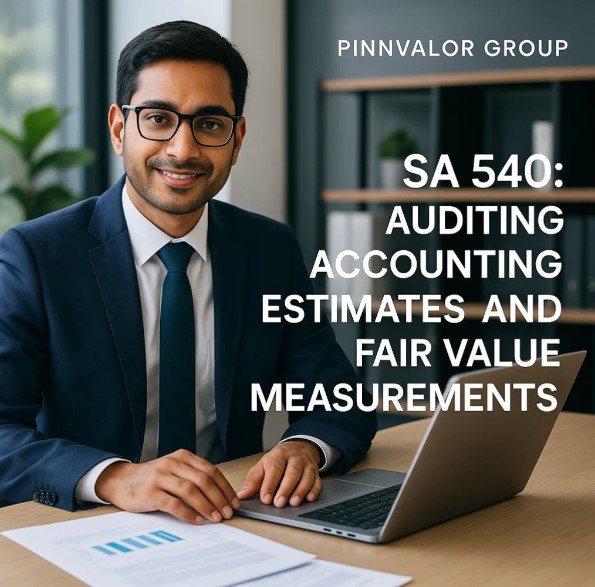
SA 540: Auditing Accounting Estimates and Fair Value Measurements
Overview: SA 540 provides guidance to auditors for evaluating accounting estimates (including fair value measurements) and related disclosures — ensuring they are reasonable, unbiased, and properly disclosed under the applicable reporting framework.
Why does SA 540 matter in today’s fair value-driven financial reporting world?
SA 540 is more than compliance—it’s about ensuring that estimates reflect reality, not bias. Reliable audits build reliable businesses.
What is SA 540?
SA 540 — Auditing Accounting Estimates and Related Disclosures sets out the auditor's responsibilities when auditing management’s estimates and the disclosures that accompany them. Estimates include fair value measurements and other judgments that affect the financial statements.
Why SA 540 Matters
- Growing reliance on estimates: Modern standards (IFRS / Ind AS) increase use of fair value and judgmental measures.
- Higher risk of misstatement: Subjectivity and uncertainty create risk of material error or bias.
- Investor confidence: Sound audit procedures around estimates bolster stakeholder trust.
Key Objectives of SA 540
- Obtain sufficient and appropriate audit evidence about accounting estimates and their disclosures.
- Assess reasonableness and bias in management's judgments and assumptions.
- Confirm presentation and disclosure comply with the applicable financial reporting framework.
Auditor’s Responsibilities Under SA 540
1. Risk Assessment
Identify and assess risks of material misstatement related to estimates — consider complexity, subjectivity, and estimation uncertainty.
2. Understanding the Entity’s Process
Obtain an understanding of how management develops estimates, including the methods, data sources, and controls used in the process.
3. Responding to Assessed Risks
Auditors typically apply one or a combination of the following procedures:
- Test management's process: Evaluate the methods, key assumptions, and the data used.
- Develop an independent estimate: Create the auditor’s estimate and compare results.
- Review subsequent events: Check transactions or events after the reporting date that provide evidence about the estimate.
4. Evaluating Disclosures
Ensure that disclosures explain the nature of the estimate, key assumptions, sensitivity to changes, and the degree of uncertainty.
5. Documentation
Document the significant judgments, risk assessment conclusions, procedures performed, and the evidence obtained.
Challenges in Auditing Estimates
- High estimation uncertainty: Examples include long-term provisions and contingent liabilities.
- Complex valuation models: Financial instrument valuations and discounting cash flows may use sophisticated models.
- Possible management bias: Tendency to choose optimistic or selective assumptions.
- Need for valuation experts: Auditors may need to rely on specialists; evaluate their competence and objectivity.
Practical Examples
- Fair value of investments: Valuing unlisted equity — verify comparable transactions, model inputs, and assumptions.
- Impairment testing (goodwill): Evaluate future cash flow projections, growth rates, and discount rates.
- Warranty provisions: Assess historical claim patterns, current product quality, and industry trends.
Best Practices for Auditors
- Exercise professional skepticism — challenge management assumptions and corroborate evidence.
- Use independent estimates when appropriate to test management’s numbers.
- Involve valuation experts for complex valuations and document how their work was used.
- Focus on disclosure quality: Ensure users can understand the uncertainty and sensitivity around estimates.
- Document thoroughly: Capture the rationale for conclusions and any differences with management.
Quick Checklist (for audit teams)
- Have you identified all significant estimates and fair value measurements?
- Did you obtain and test management’s estimation process and controls?
- Have you independently corroborated key assumptions or built an independent estimate?
- Is management bias considered and challenged?
- Are disclosures sufficient and clearly presented?
Conclusion
SA 540 is central to auditing in an age where judgment and fair value play a large role in financial reporting. Auditors must combine professional skepticism, technical knowledge, and effective use of experts to provide reliable assurance over accounting estimates and related disclosures — thereby protecting stakeholder confidence in financial statements.